
Wine Culture and Information since 2002 - Volume 22
 Wine Culture and Information since 2002 - Volume 22 |
|
Contrasts of Todi Grechetto and LuganaThe most important and representative white grape of Umbria compared to Lugana, one of the most famous white wines of Lake Garda area |
|
White wines often represent a demanding productive exercise for every winery, from the agronomist to the wine maker. Assuming that making a quality wine, regardless of style and type, is always very difficult as well as expensive, succeeding in this task with white grapes is definitely more challenging. This wine making exercise becomes even more difficult in case the white grape varieties used for the production of the wine are, so to speak, not very generous in aromatic terms. This does not mean – for the sake of clarity – that making a white wine with aromatic grapes is easy: indeed, even in this case, it is definitely very difficult to get high quality results. In any case and for every type of wine, having high quality raw material – in this case, the grapes – gives a huge advantage, however destroying this heritage can also be decidedly easy due to incompetence and incapability. It is, of course, about errors to be attributed to the work of man, in particular the wine maker, who – because of the lack of competence, as well as for superficiality and incapability – can easily destroy the quality of the grape while getting as a result a mediocre wine at best. The wines that we will examine in the tasting by contrast of this month are produced with non-aromatic grapes, that is, varieties whose wines do not give the nose aromas reminiscent of grape juice. In our glasses, in fact, we will compare Todi Grechetto – produced with the homonymous grape and found in many denomination wines of Umbria, even alone – and Lugana, one of the most famous white wines of the territory of Lake Garda. This wine is produced with Trebbiano di Soave, locally known as Turbiana or Trebbiano di Lugana, a variety introduced some centuries ago in the Marches region by Venetian colonists and which, in central Italy, is called Verdicchio.
|
|
Grechetto is the most famous white berried grape of Umbria, a region where this variety is considered autochthonous. Used in most of the white wines of the green heart of Italy, Grechetto is used for the production of many IGT (Indicazione Geografica Tipica, Typical Geographical Indication) and DOC (Denominazione d'Origine Controllata, Controlled Denomination of Origin) wines. The wine area that stands out in particular for Grechetto is certainly Todi, a territory in which this white grape variety, or better to say, one of the two clones of Grechetto found in Umbria, is capable of making wines of particular finesse and typicality. It must in fact be noticed there are two clones of Grechetto and they are identified with two codes: G5 and G109. The first one is called Grechetto of Todi, the second one is instead identified as Grechetto of Orvieto. Of the two clones, the one of Orvieto is decidedly more common in the region, while the presence of Grechetto di Todi is mainly concentrated in the territory of Todi and since time immemorial. It must be noted Pliny the Elder, in his important and monumental Naturalis Historia, talks about this vine and points out that “Peculiaris est Tudernis ”, meaning “is typical of Todi ”, observing – moreover – its wines can be recognized for the characteristic bitterish taste. The wine produced with this variety – known as the G5 clone – belongs to the DOC Todi and provides, according to the production disciplinary, the minimum use of 85% of Grechetto. It should be noted that, although the use of other varieties is allowed, producers tend to use Grechetto alone, giving their wines a decidedly more distinctive connotation. Todi Grechetto wine – also known as “Grechetto di Todi” – is capable of expressing characteristics of finesse and elegance, also thanks to the higher attention producers have been dedicating to this variety in recent years. It must be noted Grechetto di Todi is characterized to the mouth by the typical bitterish taste of its wines, in addition to a good structure, an excessively exalted characteristic in the past which evidently penalized both elegance and finesse.
|
||||
|
Of the many white wines that are produced in northern Italy, Lugana is certainly one of the best known, a wine that is getting more and more popular especially in recent years. Talking about Lugana is sometimes complicated because there is not just one Lugana: we in fact have to consider there are at least two of them. In this regard it is essential to note Lugana DOC belongs to two regions – Lombardy and Veneto – and it is located in the southern part of the Lake Garda area. The grape used for its production is Turbiana, the name by which in this denomination is called Trebbiano di Soave, the same variety that was introduced by the Venetian colonists in the fifteenth century in the Marches and that here is called Verdicchio. The difference of the soils respectively characterizing the areas of Lombardy and Veneto also play a very important role in the personality of Lugana wines. In fact, there can be substantial sensorial differences depending on the type of the soil and the position of the vineyards, in particular between the wines produced with grapes harvested near Lake Garda and those in the hills. The wines produced in the hilly areas, in fact, have a more structured and often more acidic character than those produced near Lake Garda which, instead, are distinguished by a more mineral and fine character. As already mentioned, Lugana is produced with Trebbiano di Soave grape which in this territory is called Turbiana or Trebbiano di Lugana. If it is true in the Soave area this variety has now been relegated to a marginal role, in particular in favor of Garganega, in Lugana it becomes the absolute protagonist and with results of remarkable quality and enological interest. In this territory, in fact, this variety expresses a remarkable enological versatility with excellent results both in the production of still wines and sparkling wines. It should also be noted that Lugana, a wine having a long history, in recent times has become very successful because of its renewed quality. This result has been certainly obtained thanks to the work of producers in these lands who, by using better viticultural and wine making techniques, have succeeded in obtaining wines of high quality and which clearly differ from those of the past, even the recent one.
|
The wines that we will pour into the glasses of this month's tasting by contrast belong, as already mentioned, to the denominations Todi and Lugana. In this regard it is good to consider the respective production disciplinary which, in both cases, allow the use of other grapes in addition to the main ones, respectively Grechetto and Turbiana, that is Trebbiano di Soave. By choosing our wines, we will therefore pay attention to their composition and we will make sure that, in both cases, they are produced with the respective varieties alone. From a productive point of view, our choice is in favor of wines produced in inert containers, in particular the steel tank. As for Grechetto, the choice is in favor of Todi Grechetto, not to be confused with Todi Bianco. As for Lugana, the choice is in favor of a wine produced near the town of Sirmione, therefore in the Lombard side of the denomination and with a character, so to speak, lacustrine. Both wines belong to the last available vintage and are poured in tasting glasses at a temperature of 10 °C. (50 °F) Let's pour the two wines of our tasting by contrast into their respective glasses and begin the evaluation from the preliminary examination of the sensorial analysis, that is the appearance. The first wine we examine is Todi Grechetto: by tilting the glass over a white surface – a sheet of paper is enough – and look at the base. We can clearly see an intense and brilliant straw yellow color with a very high transparency. Let's now watch to the opening of the glass, where the thickness of the wine becomes thinner, and observe the nuance. We can see a clear and evident nuance of greenish yellow. Let's now examine the Lugana wine and, by keeping the glass over the white surface, evaluate its appearance. The color of this wine shows an intense and brilliant straw yellow, with a very high transparency. The nuance of Lugana, observed at the edge of the glass, towards the opening, reveals a greenish yellow hue. The olfactory profiles of Todi Grechetto and Lugana are characterized by considerable sensorial differences. Not only for the specific qualities of the respective varieties, but also for the differences of the soil and territory where they are produced. Grechetto di Todi, not to be confused with the one of Orvieto, reveals to the nose aromas that mainly recall white-fleshed fruits – such as apple and pear – as well as plum, peach and citrus fruits, in particular lemon. Moreover, we can recognize floral aromas of hawthorn and broom, sometimes followed by aromas of exotic fruit, in particular pineapple. In Grechetto is also perceived a nutty aroma, a quality giving a certain personality to its wines. Wines produced with Trebbiano di Soave – Turbiana or Trebbiano di Lugana – are characterized by aromas of apple, pear and plum, to which follows a pleasant citrus note in which is usually recognized tangerine. Moreover, we can also perceive aromas of hawthorn, broom, peach and a characteristic almond note. In Lugana, especially those produced near the Lake Garda, is also perceived a pleasant mineral note and hints of exotic fruit, in particular pineapple. Let's focus again on the two glasses of our tasting by contrast and begin the evaluation of the olfactory profiles of the two wines, starting from Todi Grechetto. By holding the glass in vertical position and, without swirling, we perform the first smell in order to evaluate the opening of the wine, that is the identifying olfactory sensations. To the nose we perceive intense and clean aromas of apple, pear and plum, as well as a pleasant floral aroma of hawthorn. Let's proceed with the swirling of the glass – operation favoring the development of the other aromas – and perform the second smell. The olfactory profile of Todi Grechetto is completed with aromas of peach, citrus fruits and broom, in addition to the characteristic hazelnut aroma. Let's now pass to the Lugana wine and, by keeping the glass in vertical position and without swirling, we evaluate its opening. From the glass we perceive intense and clean aromas of apple, peach and a hint of citrus fruits in which tangerine is recognized. After having swirled the glass, the olfactory profile of Lugana is completed with pear, plum, broom and almond, to which is often added a touch of exotic fruit in which we can recognize pineapple. Let's continue our tasting by contrast to the gustatory analysis of the two wines, starting – as in the previous phases – from Todi Grechetto. Let's take a sip of the Umbrian white wine and evaluate its attack, that is the initial sensations that are perceived in the mouth. The wine gives our senses a clear and vibrant acidity that finds its balance in the effect of alcohol. In the mouth we also perceive an evident structure in addition to a good correspondence to the nose: the flavors of apple, pear, plum and peach are clearly perceptible. Let's move on to the gustatory evaluation of Lugana wine and take a sip in order to evaluate its attack. Also in this case we perceive an intense and pleasing crispness given by acidity and which finds its balance in the roundness of alcohol. The structure is very good, however lesser than Todi Grechetto and there is also a good correspondence to the nose. We can in fact perceive the clean and pleasing flavors of apple, peach, pear and a hint of citrus fruits in which can be recognized tangerine. Let's conclude the tasting by contrast of this month with the evaluation of the final sensations the two wines leave in the mouth after swallowing, in particular the taste-olfactory persistence. The first wine of which we evaluate the finish is Todi Grechetto: the persistence of this wine is good and in the mouth we can still perceive the pleasant crispness of acidity as well as the sensation of good structure. We also perceive the flavors of pear, apple and plum as well as the typical bitterish sensation typical in the finish of Grechetto di Todi. Let's now pass to the evaluation of the finish of Lugana: also in this case we perceive a good taste-olfactory persistence, as well as the pleasing sensation of acidity and, compared to Grechetto, we perceive a lighter yet elegant structure. In the mouth we can perceive the flavors of apple, pear, peach and tangerine as well as a sensation recalling almonds. Finally, let's put the glasses side by side and do a last smell of the wines: the olfactory differences between Todi Grechetto and Lugana are clear.
|
||||||||
Wines of the Month |
|
|
|
Score legend Prices are to be considered as indicative. Prices may vary according to the country or the shop where wines are bought |
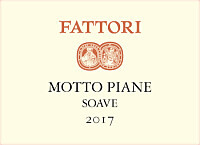
|
|
Soave Motto Piane 2017 |
|
| Fattori (Veneto, Italy) | |
 Garganega Garganega | |
| Price: € 11.80 | Score: |
 Brilliant golden yellow and nuances of straw yellow, very transparent. Brilliant golden yellow and nuances of straw yellow, very transparent. Intense, clean, pleasing, refined and elegant, starts with hints of
apple, plum and medlar followed by aromas of pear, peach, citrus fruits,
pineapple, hawthorn, broom, honey, almond and sage. Intense, clean, pleasing, refined and elegant, starts with hints of
apple, plum and medlar followed by aromas of pear, peach, citrus fruits,
pineapple, hawthorn, broom, honey, almond and sage.
 Crisp attack and however balanced by alcohol, good body, intense
flavors, pleasing roundness. Crisp attack and however balanced by alcohol, good body, intense
flavors, pleasing roundness.
 Persistent finish with flavors of apple, plum and medlar. Persistent finish with flavors of apple, plum and medlar. Made from Garganega grapes dried for 30 days, aged in steel tanks
and cask. Made from Garganega grapes dried for 30 days, aged in steel tanks
and cask.
|
|
 Pasta and risotto with vegetables and crustaceans, Mushrooms soups, Sauteed white meat, Roasted fish Pasta and risotto with vegetables and crustaceans, Mushrooms soups, Sauteed white meat, Roasted fish |
|
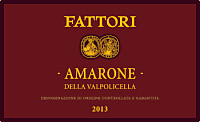
|
|
Amarone della Valpolicella 2013 |
|
| Fattori (Veneto, Italy) | |
 Corvina (65%), Corvinone (15%). Rondinella (10%), Other Grapes (10%) Corvina (65%), Corvinone (15%). Rondinella (10%), Other Grapes (10%) | |
| Price: € 48.20 | Score: |
 Intense ruby red and nuances of garnet red, little transparency. Intense ruby red and nuances of garnet red, little transparency. Intense, clean, pleasing, refined and elegant, starts with hints of
plum, blackberry and dried violet followed by aromas of black cherry,
blueberry, iris, chocolate, face powder, tobacco, cinnamon, licorice,
leather, pink pepper, vanilla and menthol. Intense, clean, pleasing, refined and elegant, starts with hints of
plum, blackberry and dried violet followed by aromas of black cherry,
blueberry, iris, chocolate, face powder, tobacco, cinnamon, licorice,
leather, pink pepper, vanilla and menthol.
 Tannic attack and however balanced by alcohol, full body, intense
flavors, pleasing roundness. Tannic attack and however balanced by alcohol, full body, intense
flavors, pleasing roundness.
 Very persistent finish with long flavors of plum, blackberry and black
cherry. Very persistent finish with long flavors of plum, blackberry and black
cherry.
 36 months in cask. 36 months in cask. |
|
 Game, Braised and stewed meat, Roasted meat, Hard cheese Game, Braised and stewed meat, Roasted meat, Hard cheese |
|
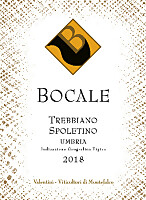
|
|
Trebbiano Spoletino 2018 |
|
| Bocale (Umbria, Italy) | |
 Trebbiano Spoletino Trebbiano Spoletino | |
| Price: € 14.00 | Score: |
 Intense golden yellow and nuances of straw yellow, very transparent. Intense golden yellow and nuances of straw yellow, very transparent. Intense, clean, pleasing and refined, starts with hints of peach,
medlar and apple followed by aromas of hawthorn, pear, litchi, broom, plum,
melon e citrus fruits. Intense, clean, pleasing and refined, starts with hints of peach,
medlar and apple followed by aromas of hawthorn, pear, litchi, broom, plum,
melon e citrus fruits.
 Crisp attack and however balanced by alcohol, good body, intense
flavors, pleasing roundness. Crisp attack and however balanced by alcohol, good body, intense
flavors, pleasing roundness.
 Persistent finish with flavors of peach, medlar and lychee. Persistent finish with flavors of peach, medlar and lychee. 6 months in steel tanks. 6 months in steel tanks. |
|
 Stuffed pasta, Broiled crustaceans, Roasted white meat, Roasted fish, Mushroom soups Stuffed pasta, Broiled crustaceans, Roasted white meat, Roasted fish, Mushroom soups |
|
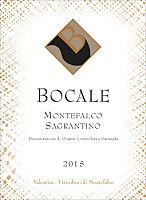
|
|
Montefalco Sagrantino 2015 |
|
| Bocale (Umbria, Italy) | |
 Sagrantino Sagrantino | |
| Price: € 29.00 | Score: |
 Deep ruby red and nuances of ruby red, little transparency. Deep ruby red and nuances of ruby red, little transparency. Intense, clean, pleasing and refined, starts with hints of blackberry,
plum and black cherry followed by aromas of violet, blueberry, cocoa,
tobacco, face powder, cinnamon, mace and vanilla. Intense, clean, pleasing and refined, starts with hints of blackberry,
plum and black cherry followed by aromas of violet, blueberry, cocoa,
tobacco, face powder, cinnamon, mace and vanilla.
 Tannic attack and however balanced by alcohol, full body, intense
flavors, agreeable. Tannic attack and however balanced by alcohol, full body, intense
flavors, agreeable.
 Persistent finish with flavors of blackberry, plum and black cherry. Persistent finish with flavors of blackberry, plum and black cherry. 24 months in cask, 12 months in bottle. 24 months in cask, 12 months in bottle. |
|
 Game, Braised and stewed meat, Roasted meat, Hard cheese Game, Braised and stewed meat, Roasted meat, Hard cheese |
|
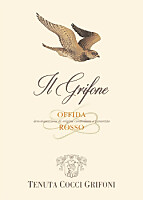
|
|
Offida Rosso Il Grifone 2013 |
|
| Tenuta Cocci Grifoni (Marches, Italy) | |
 Montepulciano Montepulciano | |
| Price: € 20.00 | Score: |
 Deep ruby red and nuances of ruby red, little transparent. Deep ruby red and nuances of ruby red, little transparent. Intense, clean, pleasing, refined and elegant, starts with hints of
plum, blueberry and black cherry followed by aromas of violet, blackberry,
chocolate, tobacco, leather, licorice, mace, vanilla and menthol. Intense, clean, pleasing, refined and elegant, starts with hints of
plum, blueberry and black cherry followed by aromas of violet, blackberry,
chocolate, tobacco, leather, licorice, mace, vanilla and menthol.
 Tannic attack and however balanced by alcohol, good body, intense
flavors, agreeable. Tannic attack and however balanced by alcohol, good body, intense
flavors, agreeable.
 Persistent finish with flavors of plum, blueberry and black cherry. Persistent finish with flavors of plum, blueberry and black cherry. 30 months in cask, at least 6 months in bottle. 30 months in cask, at least 6 months in bottle. |
|
 Game, Roasted meat, Stewed and braised meat, Hard cheese Game, Roasted meat, Stewed and braised meat, Hard cheese |
|
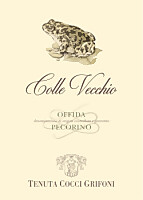
|
|
Offida Pecorino Colle Vecchio 2017 |
|
| Tenuta Cocci Grifoni (Marches, Italy) | |
 Pecorino Pecorino | |
| Price: € 13.00 | Score: |
 Intense golden yellow and nuances of golden yellow, very transparent. Intense golden yellow and nuances of golden yellow, very transparent. Intense, clean, pleasing, refined and elegant, starts with hints of
plum, apple and medlar followed by aromas of pear, hawthorn, peach,
bergamot, broom, pineapple, hazelnut, mint and mineral. Intense, clean, pleasing, refined and elegant, starts with hints of
plum, apple and medlar followed by aromas of pear, hawthorn, peach,
bergamot, broom, pineapple, hazelnut, mint and mineral.
 Crisp attack and however balanced by alcohol, good body, intense
flavors, pleasing roundness. Crisp attack and however balanced by alcohol, good body, intense
flavors, pleasing roundness.
 Persistent finish with flavors of plum, apple and medlar. Persistent finish with flavors of plum, apple and medlar. 6 months in steel tanks, 12 months in bottle. 6 months in steel tanks, 12 months in bottle. |
|
 Stuffed pasta with mushrooms, Roasted fish, Roasted white meat Stuffed pasta with mushrooms, Roasted fish, Roasted white meat |
|

|
|
Montefalco Sagrantino Colle alle Macchie 2014 |
|
| Tabarrini (Umbria, Italy) | |
 Sagrantino Sagrantino | |
| Price: € 45.00 | Score: |
 Intense ruby red and nuances of garnet red, little transparency. Intense ruby red and nuances of garnet red, little transparency. Intense, clean, pleasing, refined and elegant, starts with hints of
blackberry, black cherry and plum followed by aromas of violet, blueberry,
chocolate, tamarind, tobacco, graphite, leather, mace, pink pepper, vanilla
and menthol. Intense, clean, pleasing, refined and elegant, starts with hints of
blackberry, black cherry and plum followed by aromas of violet, blueberry,
chocolate, tamarind, tobacco, graphite, leather, mace, pink pepper, vanilla
and menthol.
 Tannic attack and however balanced by alcohol, full body, intense
flavors, agreeable. Tannic attack and however balanced by alcohol, full body, intense
flavors, agreeable.
 Very persistent finish with long flavors of blackberry, plum and black
cherry. Very persistent finish with long flavors of blackberry, plum and black
cherry.
 36 months in cask, 12 months in bottle. 36 months in cask, 12 months in bottle. |
|
 Game, Braised and stewed meat, Roasted meat, Hard cheese Game, Braised and stewed meat, Roasted meat, Hard cheese |
|
|
|
|
Adarmando 2017 |
|
| Tabarrini (Umbria, Italy) | |
 Trebbiano Spoletino Trebbiano Spoletino | |
| Price: € 18.00 | Score: |
 Intense golden yellow and nuances of golden yellow, very transparent. Intense golden yellow and nuances of golden yellow, very transparent. Intense, clean, pleasing, refined and elegant, starts with hints of
quince, medlar and lychee followed by aromas of apple, peach, pear, citrus
fruits, pineapple, hawthorn, broom, plum, hazelnut, honey and mineral. Intense, clean, pleasing, refined and elegant, starts with hints of
quince, medlar and lychee followed by aromas of apple, peach, pear, citrus
fruits, pineapple, hawthorn, broom, plum, hazelnut, honey and mineral.
 Crisp attack and however balanced by alcohol, good body, intense
flavors, pleasing roundness. Crisp attack and however balanced by alcohol, good body, intense
flavors, pleasing roundness.
 Persistent finish with flavors of quince, medlar and lychee. Persistent finish with flavors of quince, medlar and lychee. At least 12 months in steel tanks, 6 months in bottle. At least 12 months in steel tanks, 6 months in bottle. |
|
 Stuffed pasta, Pasta and risotto with mushrooms and crustaceans, Roasted white meat, Stewed fish, Roasted fish Stuffed pasta, Pasta and risotto with mushrooms and crustaceans, Roasted white meat, Stewed fish, Roasted fish |
|
|
||||||||
|
DiWineTaste Polls
|
| |||||||
Privacy Policy | |||||||


| Copyright © 2002-2024 Antonello Biancalana, DiWineTaste - All rights reserved |
| All rights reserved under international copyright conventions. No part of this publication and of this WEB site may be
reproduced or utilized in any form or by any means, electronic or mechanical, without permission in writing from DiWineTaste. |